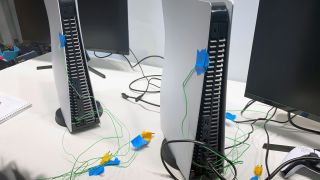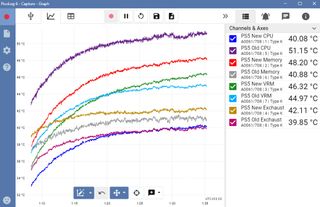Lighter, Smaller PlayStation 5 Cooler is Actually Better, Tests Say
The SoC runs cooler while VRM and memory run a tad hotter

According to in-depth testing from HardwareBusters, it appears that the new cooler that ships in the PlayStation 5 actually performs better than the original, adding yet more controversy to what has become an ongoing saga. We've previously reported about the new revision of the PlayStation 5 console that hit the market with a smaller and lighter heatsink. The heatsink was originally tested by a popular YouTube channel that theorized that the cooler didn't work as well as the larger cooler found on the original system, but follow-up anecdotal testing showed no difference in real-world performance. Now even more detailed testing has been posted, with the results suggesting that the new PS5 revision actually runs cooler.
HardwareBusters (via Igor's Lab) tested the launch-day PS5 against the new PS5 revision and contends that, despite the smaller cooling solution, the newer model actually cools the system better. The testing included measurements of external temperatures, exhaust temps, and SoC/VRAM/VRM temperature sensors under gaming load. The short version: The new PS5 model showed no serious regressions, and in fact, is actually better.
For the SoC itself, the newer PS5 revision was more than 10C cooler, with temps dropping from 51.15C with the original model to 40.08C with the newer revision.
Despite the cooler SoC, there were a few regressions with other components. The new memory (VRAM) temps have climber by around 8C, from the original 40.88C to 48.20C. The VRM power delivery modules also saw a temp increase, where the new PS5 model runs at 46.32C compared to the older one at 44.97C.
It's noteworthy that HardwareBusters is following up with more in-depth testing with various sensor placements, but the outlet says that its expanded test results simply underline that the new cooler is better than the old revision.

All those regressions combined make up for the hotter exhaust temperatures, and the results indicate that the new PS5 exhaust temps are equal to 41.11C, where the launch-day model measured 39.85C. And lastly, the new PlayStation 5 revision had a mere 1-decibel increase in noise compared to the older model, again showing no serious change.
It is important to note that these are not very significant changes and users should not worry about the well-being of their PS5 console regardless of whether they have a newer or older revision at hand. It is just a part of the console lifetime where Sony updates the design to cut costs and fixes various issues.
Stay on the Cutting Edge
Join the experts who read Tom's Hardware for the inside track on enthusiast PC tech news — and have for over 25 years. We'll send breaking news and in-depth reviews of CPUs, GPUs, AI, maker hardware and more straight to your inbox.
-
Chung Leong Incidentally, if you unplug your refrigerator, it'll run a lot cooler. The exhaust will go all the way down to room temperature.Reply -
Kamen Rider Blade I wish there was a PS5 design that didn't have any thermal regressions.Reply
For the SoC itself, the newer PS5 revision was more than 10C cooler, with temps dropping from 51.15C with the original model to 40.08C with the newer revision.Despite the cooler SoC, there were a few regressions with other components. The new memory (VRAM) temps have climber by around 8C, from the original 40.88C to 48.20C. The VRM power delivery modules also saw a temp increase, where the new PS5 model runs at 46.32C compared to the older one at 44.97C
It's nice that the SoC dropped by 11.07°C, but the RAM going up by 7.32°C & VRM going up by 1.35°C isn't good for long term longevity IMO. -
VforV Now all we need is GN to give us the definitive test and then Austin Evans can go back to acting school, because his acted excuses don't hold up well. We know what he is...Reply
1435463804779995136 -
Phaaze88 Reply
Isn't this well within spec though? These SoCs and memory chips can tolerate much higher than that, so what am I missing? Because it looks like Sony saved a few bucks and thermal operations are still darn good.Kamen Rider Blade said:The new memory (VRAM) temps have climber by around 8C, from the original 40.88C to 48.20C. The VRM power delivery modules also saw a temp increase, where the new PS5 model runs at 46.32C compared to the older one at 44.97C -
Kamen Rider Blade Reply
Every Integrated Circuit can tolerate higher thermals than that, but long term reliability is proportional to operating at higher temperatures over long periods of time.Phaaze88 said:Isn't this well within spec though? These SoCs and memory chips can tolerate much higher than that, so what am I missing? Because it looks like Sony saved a few bucks and thermal operations are still darn good.
The 11.07°C drop is a giant improvement for the SoC, that's great and all; but the RAM going up by 7.32°C & VRM going up by 1.35°C isn't good for long term longevity IMO .
It'll be fine in the short term, the here and now; but I'm thinking long term, many years down the line.
Constantly operating at higher temperatures doesn't do any favors for the RAM or VRM portions.
If you want longer term reliability, you want everything to operate at the coolest possible temperatures that are practical.
But I'm sure somebody is already working on another hardware revision.
Maybe one where there is no Thermal Regressions and only improvements. -
Phaaze88 People who don't dust out their consoles is likely a bigger long term killer than the temperature changes happening here...Reply -
artk2219 ReplyKamen Rider Blade said:I wish there was a PS5 design that didn't have any thermal regressions.
For the SoC itself, the newer PS5 revision was more than 10C cooler, with temps dropping from 51.15C with the original model to 40.08C with the newer revision.
Despite the cooler SoC, there were a few regressions with other components. The new memory (VRAM) temps have climber by around 8C, from the original 40.88C to 48.20C. The VRM power delivery modules also saw a temp increase, where the new PS5 model runs at 46.32C compared to the older one at 44.97C
It's nice that the SoC dropped by 11.07°C, but the RAM going up by 7.32°C & VRM going up by 1.35°C isn't good for long term longevity IMO.
The temps are still icy compared to their thermal limits, even if the VRM's were running at 60C thats still well within what is likely a 100 - 110c spec tolerance (VRM's are made to run hot if they have to, do not let them run that hot long term though). The RAM is a bit trickier and very much depends on the chips they used. The DDR4 spec says that long term anything under 80c is fine, but errors can start popping up around temps as low as 40c with certain chips, and others dont see errors until 70c. I'm assuming they did their homework and got some chips that can handle the extra heat, but then im reminded or the RROD and the YLOD and it makes me wonder if we'll see some memory issues long term. It's likely just fine, but we'll see as time progresses, either way the 10c drop on the SOC is awesome and much more likely to keep the console working long term. -
VforV Reply
At least we know/expect the PS5 Slim, which should come in 2022 will be an improvement across the board. It should be.Kamen Rider Blade said:But I'm sure somebody is already working on another hardware revision.
Maybe one where there is no Thermal Regressions and only improvements. -
anemusek I have a strange feeling that the lower soc temperature is due to a performance limitation. We will wait for the testsReply
Most Popular


